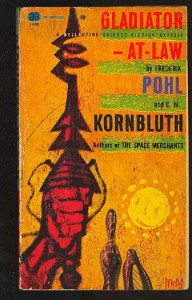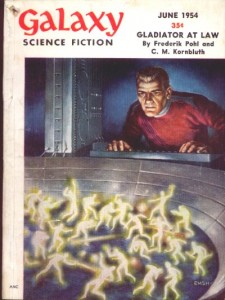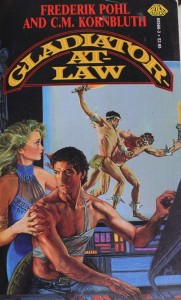Return to Introduction
Return to The Space Merchants
Return to Search the Sky
Return to Two Solo Novels: The Syndic and Drunkard’s Walk
Gladiator-at-Law
by Frederik Pohl and C. M. Kornbluth
Original publication: as a three-part serial in Galaxy Science Fiction, June-August, 1954; Ballantine Books, 1955 (hardback/paperback)
Most recent publication: Baen Books, 1986 (paperback, revised by Frederik Pohl from 1955 edition)
Of the four Frederik Pohl-Cyril Kornbluth novel-length collaborations, I think their third, Gladiator-at-Law, is my favorite. Not because it offered the most relevant social satire – that would be The Space Merchants — nor because it was the most imaginatively audacious – that would be Wolfbane. However, I found it to be the most entertaining of the four books. In large part I was thoroughly entertained because of the novel’s large cast of well-drawn, sympathetic, and ultimately endearing characters.
This isn’t to say that Gladiator-at-Law is without its satisfactions as social satire or regarding the science fictional ideas it presents. It is fairly rich in both, even if it doesn’t quite match up to The Space Merchants when it comes to social satire or to Wolfbane when it comes to bat-sh%t-crazy sense-of-wonder concepts. One of the central notions presented in Gladiator-at-Law is that corporate law firms have become the most powerful elements in a future American society (as opposed to The Space Merchants’ advertising firms). The rationale for the rise and supremacy of corporate law firms is not offered with nearly the same level of exposition as the rise of advertising firms was in the earlier novel. However, a rather compelling rationale is offered regarding how major corporations maintain a chokehold on their most valued employees. They entrap employees with the honeypots of subsidized housing. And not just any subsidized housing, but what is referred to as “bubble housing,” or G.M.L. Homes (short for Gorman-Mofatt-Lavin Homes, Gorman and Lavin having been the inventors of the “machines for living in” and Mofatt the vital money man).
What is it that makes a G.M.L. Home so desirable – so desirable, in fact, that any neighborhoods or subdivisions made up of non-bubble housing are considered substandard and quickly devolve into slums for the poor and working classes? G.M.L. Homes are completely and instantly configurable by their residents. Locations of walls, doors, windows, furniture, and appliances may be changed at the press of a button or the twirl of a dial. Colors of wall paper or pieces of artwork can be switched on a whim. The home is self-cleaning and self-maintaining. It cooks meals automatically, massages its residents to sleep, wakes them at the proper time in the morning, and assists them with personal hygiene and dressing, so efficiently that the typical businessman can go from asleep in bed to walking out the door in less than ninety seconds. The residents of G.M.L. homes quickly become dependent upon the conveniences and luxuries that a bubble house can provide. Which is very much to the benefit of the companies which employ those residents, for bubble houses are too expensive for individual citizens to purchase and must be provided by corporations, which lease them and then make them part of their employees’ compensation packages. Thus, for nearly all white-collar and professional employees, losing their job also means losing their bubble house, which means being thrust into one of the slums made up of traditional, non-bubble housing. Fear of this outcome is sufficient to keep most employees tethered to their employers for life.
What fascinates me most about Gladiator-at-Law is the way that Pohl and Kornbluth were able to foresee the evolution of many of the cookie-cutter suburbs which were constructed for returning GI’s and their families after the Second World War, when the GI Bill opened up the possibilities of home ownership and a college education to veterans. Some of those early suburbs, such as the original Levittown on Long Island, have been able to maintain their desirability as middle-class places of residence, due to their physical proximity to healthy, jobs-rich urban cores and to sufficient public transportation and highways. Many others, however, what are now commonly called “inner ring suburbs,” have been abandoned by the middle and professional classes, who have moved to more modern and spacious housing farther away from the central cities. The newer residents of these inner ring suburbs are recent immigrants or poor or working class residents who have moved out of the city centers (often when those city centers have become gentrified and re-occupied by the same sorts of white-collar and professional residents who fled them after the Second World War). One of the novel’s primary settings, the slum called Belly Rave, was built as a GI Bill suburb shortly after WWII and was originally called Belle Reve. In lots of the metropolitan areas of the Northeast and Midwest, the actual post-WWII Belle Reves have devolved into suburban slums not very much different from the portrayal of Belly Rave in Gladiator-at-Law.
The other significant social extrapolation made by Pohl and Kornbluth in this novel is the rise of ultra-violent entertainments for the suburban masses, provided in a “bread and circuses” format in coliseum-like stadiums. The combatants are either drunken thrill-seekers or impoverished wretches who see no other possible future than to commit themselves to a likely death or maiming in the chance of earning some money. With a few tweaks, what the authors suggested back in 1954 can be seen as a prediction of some of what makes up our current smorgasbord of reality television, shows such as Survivor, Fear Factor, Wipeout, I Survived a Japanese Game Show, and Dog Eat Dog, which place (supposedly) non-actors and non-stunt people in potentially hazardous situations and environments. The format has been extended to the ranks of the moderately or formerly famous with Celebrity Circus, in which viewers get to watch people they might actually recognize risk their necks. Whether one views the explosion of reality TV as a welcome widening of America’s entertainment options or as a prime example of the coarsening and decline of popular entertainment, it is interesting to note that the phenomenon was not instigated by a coordinated plan among programming executives at the major networks, but rather by an economic event – the November, 2007 to February, 2008 strike of the Writers Guild of America, which shut down the production of what had been the heart of network TV’s evening schedules – scripted comedies and dramas. Reality TV shows, primarily adapted from British models at first, were rushed into production to plug holes in network schedules. When they proved to be both popular and relatively cheap (compared to scripted comedies and dramas), the major networks and many cable channels shifted a significant amount of programming hours towards what had originally been thought to be a stop-gap measure. And Cyril Kornbluth looks down from SF writers’ heaven and enjoys a wry chuckle at our expense.
Another factor which greatly adds to the appeal of Gladiator-at-Law (and which helps keep this nearly sixty-year-old genre novel fresh for new audiences) is the high quality of its characterizations. Virtually all of the primary characters begin their story arcs as losers of some kind – some as lovable losers, others as rather contemptible losers. By the end of the novel, each of these characters has been challenged to rise above his or her former station and to perform daring acts they would not have dreamed of accomplishing at the book’s beginning. Charles Mundin starts the book as a criminal lawyer barely scraping by on other lawyers’ leavings and charity cases thrown to him by his low-level connections in the local political ward hierarchy. Donald and Norma Lavin, the rightful heirs to the G.M.L. Homes fortune, are locked out of their inheritance by the machinations of G.M.L. and the shadowy, powerful corporate law firm of Green, Charlesworth, and Donald has been reduced to a brainwashed semi-moron to keep him from remembering the location of his stock certificates. Norvell Bligh is a fearful, easily intimidated designer of blood-sport spectacles for a third-rate production company, responsible for upcoming Field Day shows, barely hanging onto his job and the bubble house that comes with it. His shrewish wife, Virginia, and her lazy, disrespectful daughter, Alexandra, both of whom have climbed out of their origins in the slum of Belly Rave, only make Norvell’s existence more hellish. Yet by the end of the novel, each of these characters has been transformed, mostly of their own volition and due to their own initiative. Together, they form an extended family and team capable of facing down the mighty firm of Green, Charlesworth and restoring some of the original promise of Gorman’s and Lavin’s invention to improve the lives of common working people, rather than enslave them.
Pohl’s and Kornbluth’s story, while a critique of predatory capitalism, does not condemn capitalism as an economic system. Rather, it suggests that, as an economic system, it is only as humane and civic-minded as the people who participate in it. The novel suggests that people such as its protagonists, who have both suffered from the worst excesses of capitalism and who have experienced their ability to better themselves through utilizing capitalism’s tools, may be the types of “captains of industry” capitalism needs to fulfill its potential as an enabler of human progress and happiness.








Another great article. Gladiator at Law is a very entertaining novel. I have commented elsewhere about the fantastic stock market scene:
“Mundin figured. That meant that the investors would lay of chemicals because of the rise – except for the investors who would be on chemicals because they would figure everybody would lay off chemicals because they’d figure everybody would be on chemicals. Because of the rise.”
Simply brilliant. As a novel, I personally preferred Space Merchants, however, because I feel that the first half of G.A.L. is markedly superior to the second. Strangely, for most of the novel, the characters suffer no dramatic setbacks, which makes the middle sag somewhat.
Matthew, thanks so much for commenting. I didn’t note myself that the middle of GLADIATOR-AT-LAW suffered from any sag; I guess I was enjoying the characters too much to notice!